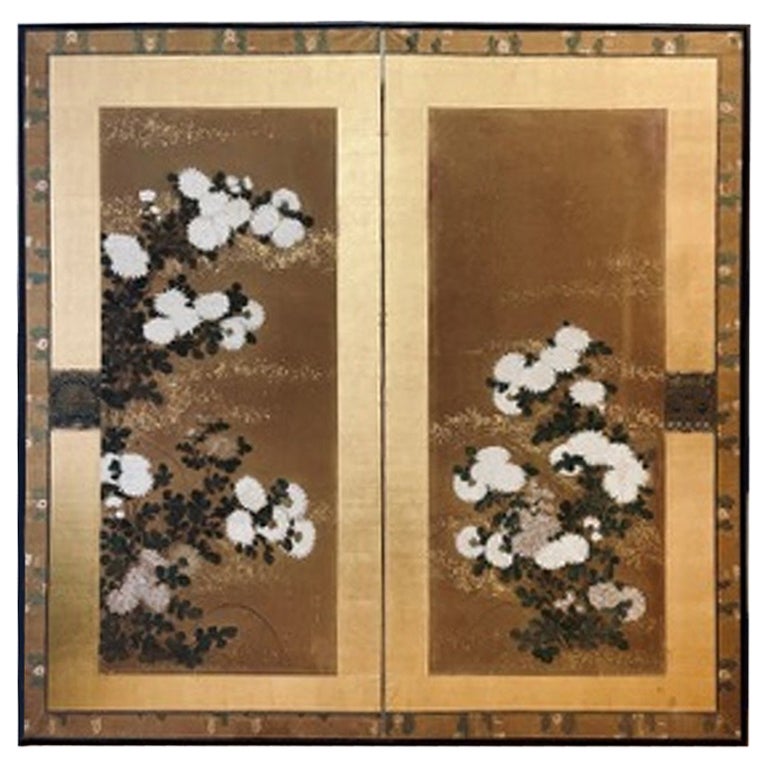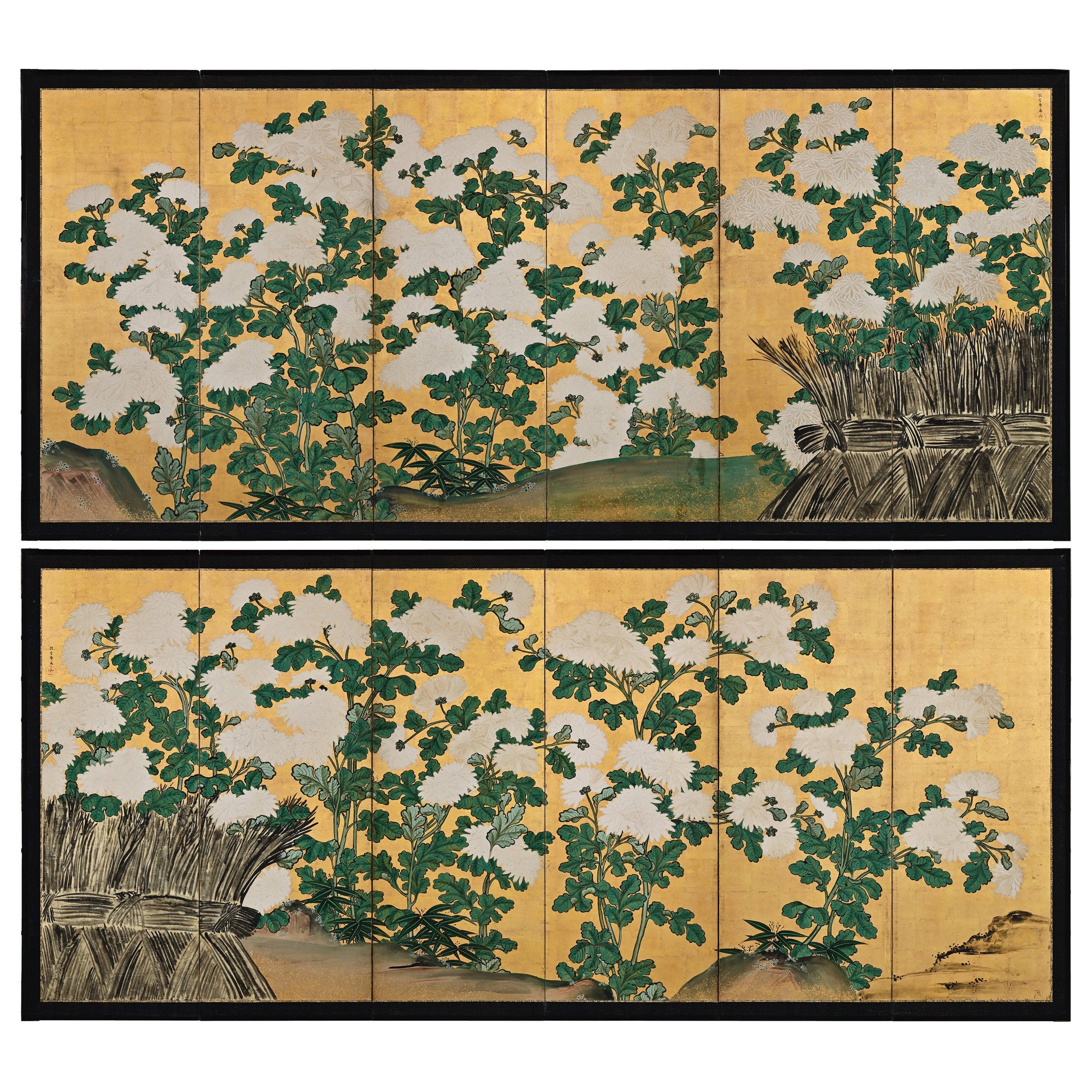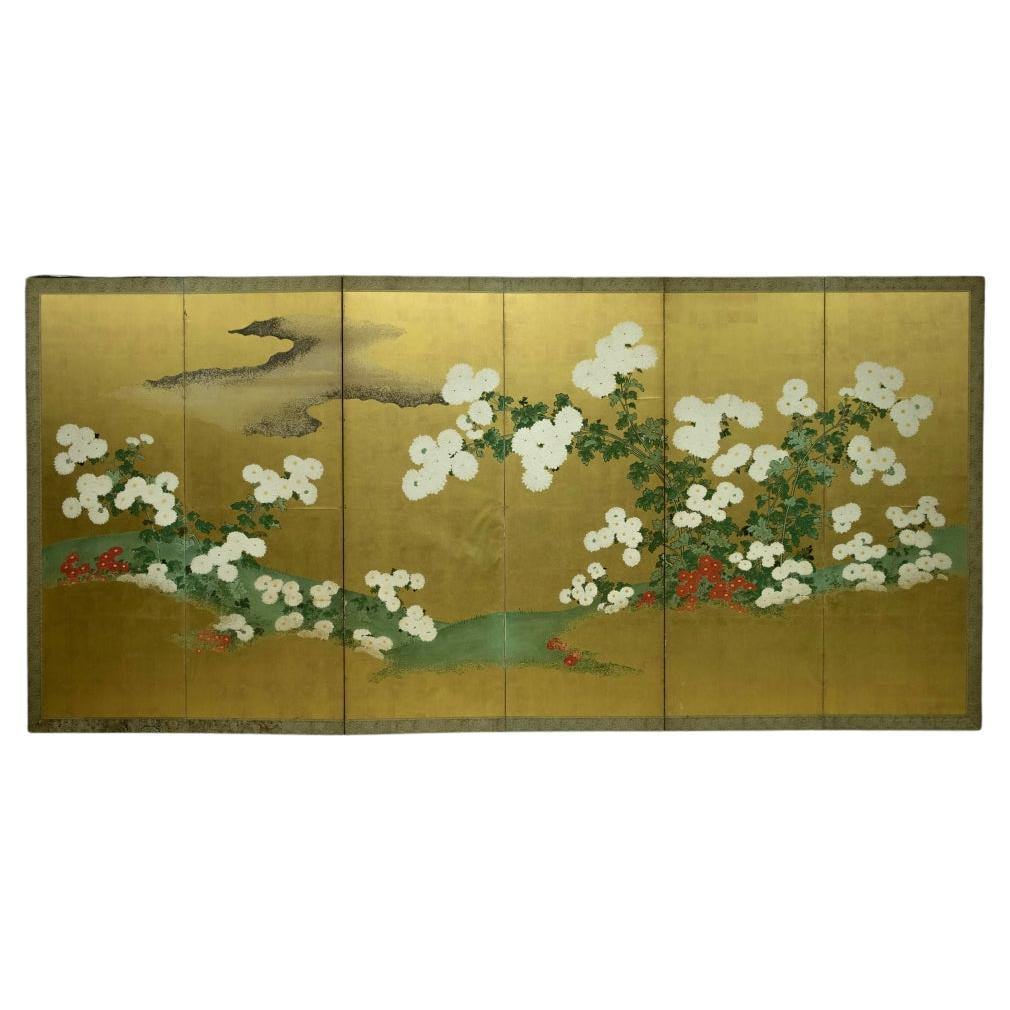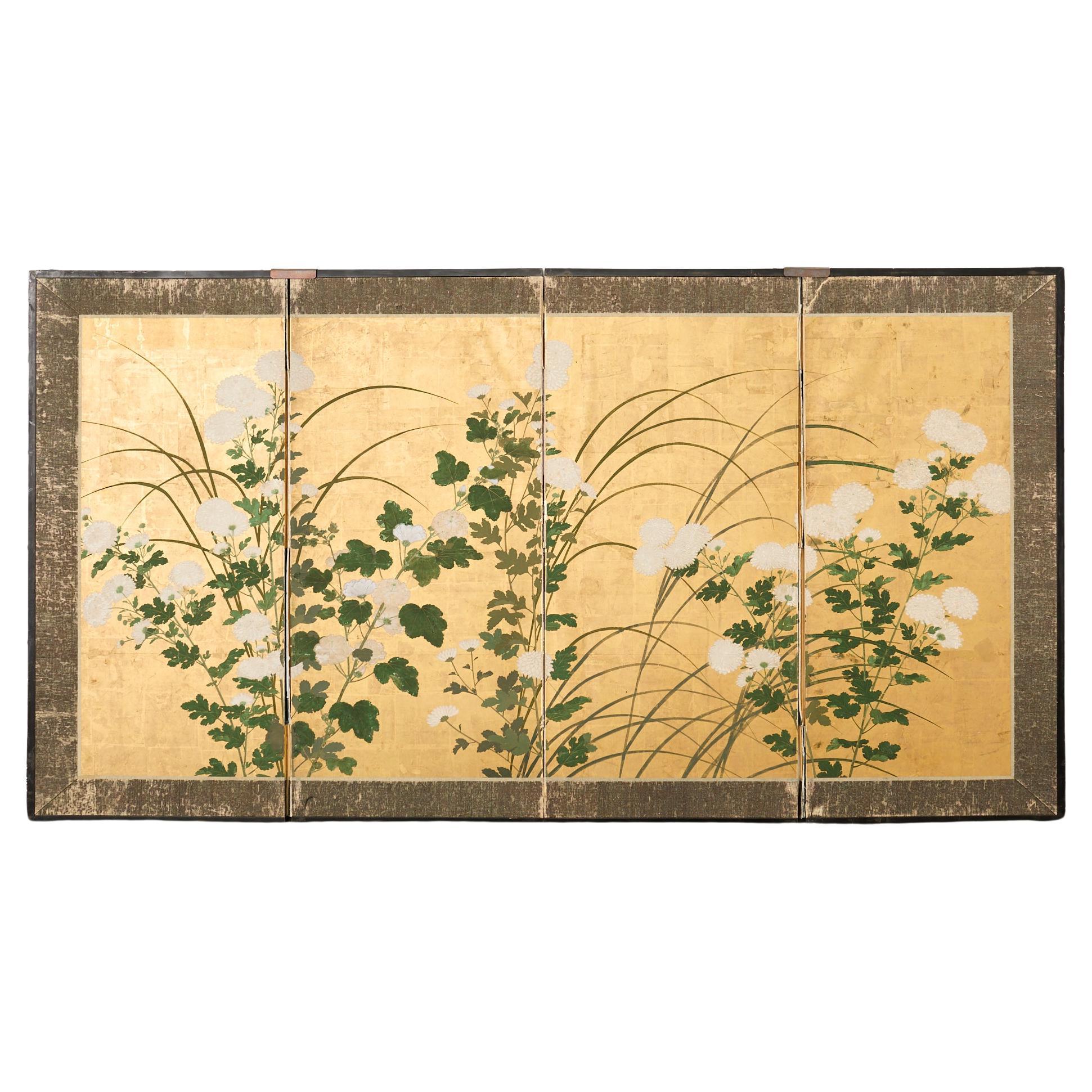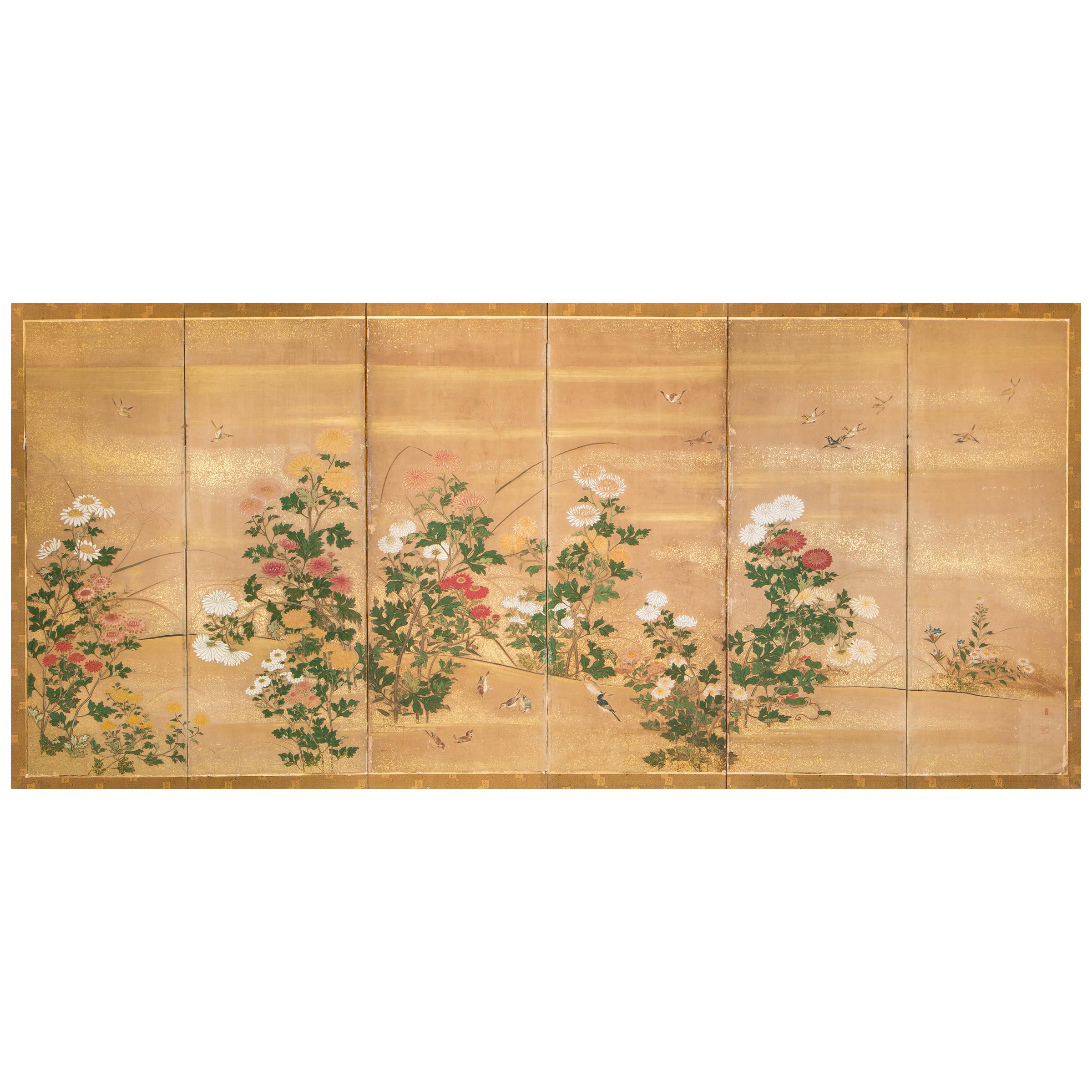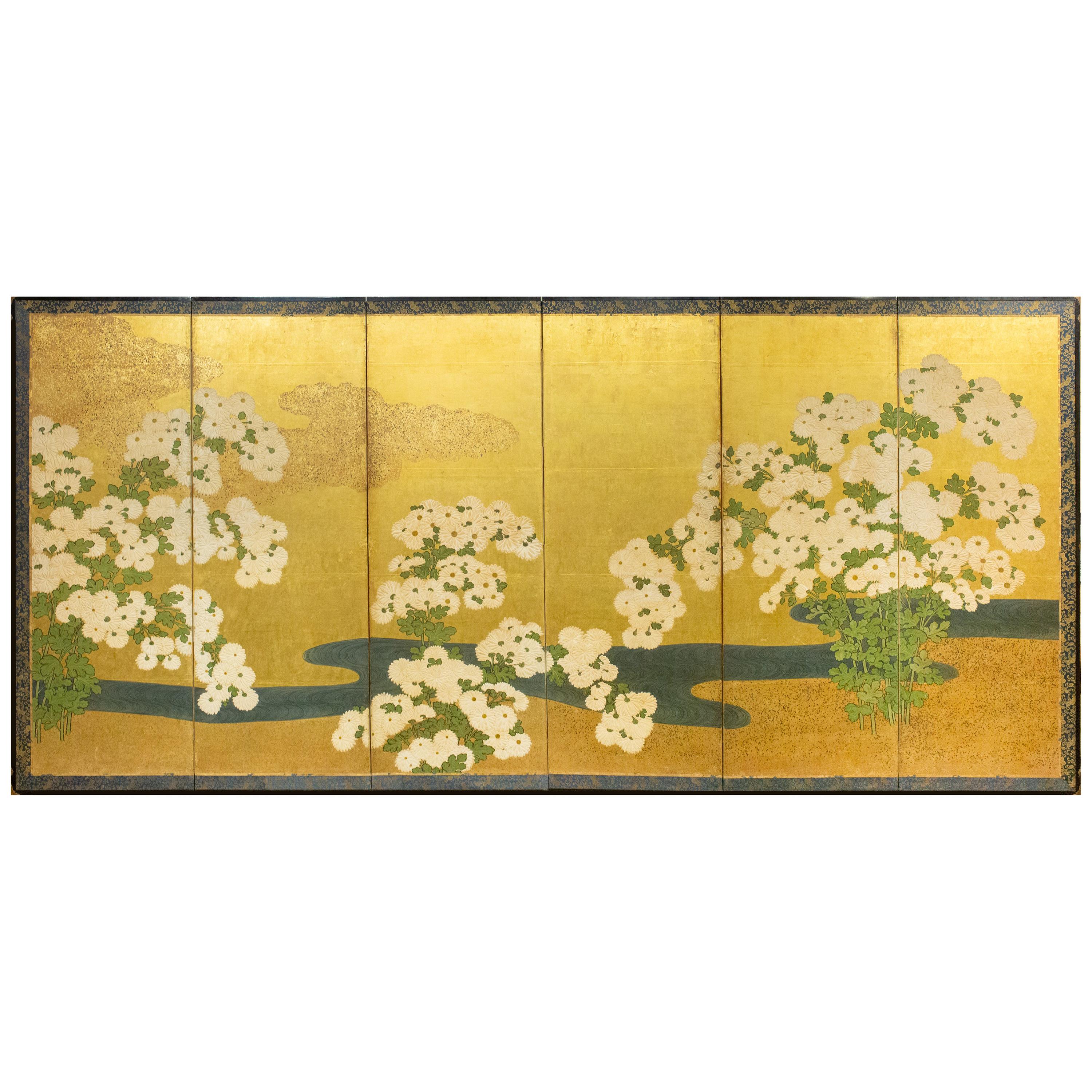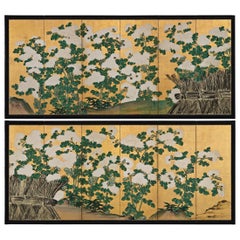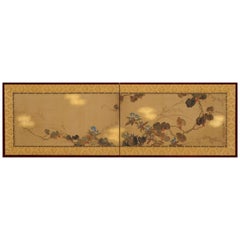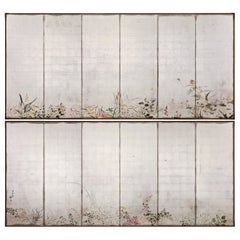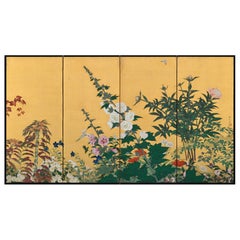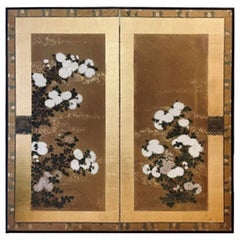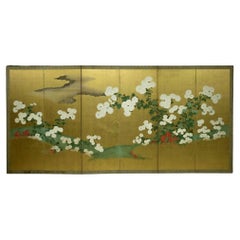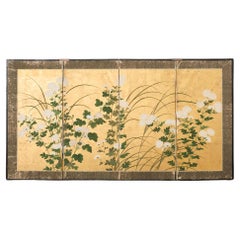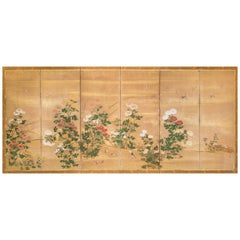Artículos similares a 18th Century Japanese Rinpa Screen. White Chrysanthemums. School of Korin.
¿Quieres más imágenes o vídeos?
Solicita imágenes o vídeos adicionales al vendedor
1 de 10
18th Century Japanese Rinpa Screen. White Chrysanthemums. School of Korin.
27.804,32 €
Envío
Recuperando presupuesto…La promesa de 1stDibs
Garantía de autenticidad,
Garantía de devolución de dinero,
Cancelación dentro de las 24 horas
Acerca del artículo
School of Ogata Korin
White Chrysanthemums
18th Century, Edo period.
A two-panel Japanese screen. Ink, color, gofun and gold leaf on paper.
Dimensions: H. 171 cm x W. 188 cm (67.5” x 74”)
On this two-panel Japanese screen we see blooming chrysanthemums, a flower which embodies the essence of autumn in Japan. Here the traditional floral theme has been simplified and stylized. The bright colors and asymmetrical composition against the delicate gold leaf create a luxurious and ornate work of art. Its background, a strikingly patinated grid of gold leaf, denies any sense of place or time and imbues everything with an ethereal glow. The leaves and stems of the plants are nothing more than pools of mottled color and ink without any outline whatsoever. These are typical Rinpa adaptations of traditional ink painting methods; tarashikomi, or diluted washes of color blended while very wet, and mokkotsu, or “bonelessness,” which creates forms without exterior outlines. The relief work of the rounded flower petals has been obtained by the moriage process (a mixture based on ground shells modeled on the surface of the paper).
On the lower right of the screen, the siganture “Hokyo Korin Jakumyo” and the “Hoshuku” seal can be read. Korin is Ogata Korin, famed for the Irises (Nezu Museum) and Red and White Plum Blossom (MOA Museum of Art) folding screens, both National Treasures. Korin worked in both Kyoto and Edo in the mid-Edo period. Korin was using the art name “Jakumyo” just after he received the Hokyo level, which was in 1701.
This particular screen was published in May of 1961 in the Japanese Sansai Fine Art Magazine*. An in depth article accompanies the photograph of the screen and and a photograph of the signature and seal. This article devotes much of its body to discussing the moriage technique, how it enlivens the chrysanthemum flowers and Korin’s specific skill in using the technique. The article goes on to discuss the most famous works of Korin, utilizing this technique, which were known at the time. Specifically a two-panel screen held in the Honolulu Museum which was discovered in the store-house of Takahashi Soan. A two-panel screen pair which the Nakano family own. A two-panel screen pair with chrysanthemums in moriage in fan designs owned by the Nomura family. Also a small folding screen featuring chrysanthemums held in the Yamato Bunkakan. The article goes on to say that this particular two-fold screen came from the Nijo family. Korin is known to have had a strong connection with the aristocratic Nijo family. The article explains that Korin received a lot of favors from the Nijo family and that this screen would have been gifted to them.
Since that time the Honolulu screen has been amended to ‘attributed to Ogata Korin’ and I do not know further details of the other 3 screens. Other Chrysanthemum screens utilizing the moriage technique signed and sealed Korin are held in the Guimet Museum, Smithsonian National Museum of Asian Art, Cleveland Museum of Art and the Okada Museum. The pair held in the Cleveland Museum of Art is listed as “Possibly by Ogata Korin”. The pair in the Smithsonian National Museum of Asian Art are dated to the 19th century with no attribution. The Suntory Museum holds a two-panel screen “Flowering Plants in Autumn” which features chrysanthemums in the moriage technique. This work is also “attributed to Ogata Korin”.
It is quite clear that there are serious difficulties in authenticating all of the chrysanthemum screens bearing the signatures and seals of Ogata Korin. The work being offered here clearly dates to the 18th century though is not by the hand of Ogata Korin himself. Perhaps ‘Studio of Korin’ would be appropriate. Perhaps ‘School of Korin’ would be appropriate.
*美術雑誌 三彩 1961(昭和36)年5月 138号
- Dimensiones:Altura: 171,45 cm (67,5 in)Anchura: 187,96 cm (74 in)Profundidad: 1,91 cm (0,75 in)
- Estilo:Edo (Del período)
- Materiales y técnicas:
- Lugar de origen:
- Época:
- Fecha de fabricación:Circa 1750
- Estado:Desgaste acorde con la edad y el uso.
- Ubicación del vendedor:Kyoto, JP
- Número de referencia:1stDibs: LU2472343391742
Sobre el vendedor
5,0
Vendedor reconocido
Estos prestigiosos vendedores son líderes del sector y representan el escalón más alto en cuanto a calidad y diseño de artículos.
Establecido en 2001
Vendedor de 1stDibs desde 2016
70 ventas en 1stDibs
Tiempo de respuesta usual: 6 horas
- EnvíoRecuperando presupuesto…Envío desde: Kyoto, Japón
- Política de devolución
Partes de esta página se han traducido automáticamente. 1stDibs no puede garantizar la exactitud de las traducciones. El inglés es el idioma predeterminado de este sitio web.
Garantía de autenticidad
En el improbable caso de que haya algún problema con la autenticidad de un artículo, ponte en contacto con nosotros en un plazo de 1 año para recibir un reembolso total. DetallesGarantía de devolución de dinero
Si tu artículo no es como se describe, sufre daños durante el transporte o no llega, ponte en contacto con nosotros en un plazo de 7 días para recibir un reembolso total. DetallesCancelación dentro de las 24 horas
Tienes un período de gracia de 24 horas para reconsiderar tu compra, sin preguntas.Vendedores profesionales aprobados
Nuestros vendedores de primera clase deben cumplir estrictos estándares de servicio para mantener la integridad de nuestros anuncios.Garantía de igualación de precios
Si encuentras que un vendedor publicó el mismo artículo por un precio menor en otro lado, igualaremos ese precio.Entrega global de confianza
Nuestra red de transporte de primera ofrece opciones de envío especializado en todo el mundo, que incluye envío personalizado.Más de este vendedor
Ver todoPareja de biombos japoneses de mediados del siglo XVIII, Cien flores, crisantemos
Omori Soun (n. 1704)
Crisantemos - Cien Flores
Un par de biombos japoneses séxtuples. Tinta, color, gofun y pan de oro sobre papel.
De mediados del siglo XVIII, este par de biombo...
Categoría
Antiguo, mediados del siglo XVIII, Japonés, Edo, Pinturas y biombos
Materiales
Hoja de oro
Serigrafía japonesa, principios del siglo XIX, Flores de otoño de Sakai Hoitsu
Biombo japonés del artista de la escuela Rimpa Sakai Hoitsu (1761-1828), Japón, siglo XIX, periodo Edo.
Este pequeño biombo japonés pintado por Sakai Hoitsu fue diseñado originalm...
Categoría
Antiguo, principios del siglo XIX, Japonés, Edo, Pinturas y biombos
Materiales
Madera, Seda
circa 1930 Pantallas japonesas de plata de Isoi Joshin, Flores de las Four Seasons
Flores de las cuatro estaciones
Isoi Joshin (1883-1964)
Pareja de biombos japoneses de seis paneles
Tinta, pigmento, laca y pan de plata sobre papel
Inscripción: Isoi Jo
...
Categoría
mediados del siglo XX, Asiático, Showa, Pinturas y biombos
Materiales
Hoja de plata
Biombo japonés de principios del siglo XX. Flores de las Four Seasons.
Anónimo
Flores de las Four Seasons
Una pantalla japonesa de cuatro paneles. Tinta, gofun y pigmentos sobre pan de oro.
Este biombo japonés es una rica celebración visual de las flo...
Categoría
principios del siglo XX, Japonés, Taisho, Pinturas y biombos
Materiales
Hoja de oro
Biombo japonés de flor de cerezo de principios del siglo XX por Kano Sanrakuki
Cerezos en flor
Kano Sanrakuki (1898-1981)
Periodo Showa, hacia 1930
Pantalla japonesa de 2 paneles
Color, gofun y pan de oro sobre papel
Sobre un fondo de hojas dorad...
Categoría
principios del siglo XX, Japonés, Showa, Pinturas y biombos
Materiales
Hoja de oro
Pareja de biombos japoneses del siglo XIX. Flores y aves de las Four Seasons.
Flores y aves de las Four Seasons
Pareja de biombos japoneses de seis pliegues. Tinta, color, gofun y oro sobre papel.
Segunda mitad del siglo XIX
Un par de biombos japoneses de t...
Categoría
Antiguo, Fines del siglo XIX, Japonés, Meiji, Pinturas y biombos
Materiales
Madera, Papel
También te puede gustar
Biombo japonés de dos paneles con crisantemos del periodo Edo, ca. 1750
Biombo japonés de dos paneles con crisantemos del periodo Edo, ca. 1750
ACERCA DE
Este biombo es realmente una obra maestra del diseño y la composición con un marco dorado....
Categoría
Antiguo, siglo XIX, Japonés, Japonismo, Pinturas y biombos
Materiales
Madera
Biombo en flor de crisantemo de la escuela Rinpa del periodo Edo tardío
Por Rimpa School
Biombo en flor de crisantemo de la escuela Rinpa del periodo Edo tardío
Periodo: finales de Edo, principios del siglo XIX
Tamaño: 364 x 172 cm (143 x 67 pulgadas)
SKU: PTA13
Este e...
Categoría
Antiguo, siglo XVIII, Japonés, Edo, Pinturas y biombos
Materiales
Papel
Biombo japonés Edo de cuatro paneles Crisantemos blancos en flor
Extraordinario biombo japonés de cuatro paneles del siglo XIX, de finales del periodo Edo/principios del Meiji, con crisantemos blancos en flor pintados en estilo moriage (pigmento e...
Categoría
Antiguo, siglo XIX, Japonés, Edo, Pinturas y biombos
Materiales
Latón, Hoja de oro
Biombo japonés de seis paneles, Crisantemos
Biombo japonés de seis paneles: Crisantemos, pintura del periodo Edo (hacia 1800) de una variedad de crisantemos en un paisaje de jardín, con gorriones. Pigmentos minerales sobre pap...
Categoría
Antiguo, Principios del 1800, Japonés, Edo, Pinturas y biombos
Materiales
Hoja de oro
Biombo japonés de seis paneles, crisantemos de la Rimpa School sobre oro
Un uso abundante del oro con crisantemos bellamente drapeados y nubes de escamas doradas. Pigmentos minerales, go fun, pan de oro sobre papel de morera con borde de brocado de seda.
Categoría
Antiguo, principios del siglo XIX, Japonés, Meiji, Pinturas y biombos
Materiales
Hoja de oro
Biombo Japonés de Dos Paneles: Crisantemos sobre valla de ramitas
Pigmento mineral y polvo de oro sobre papel de morera. Borde de brocado de seda y adornos de laca negra. De la colección de Moke Mokotoff
Categoría
Antiguo, Fines del siglo XIX, Japonés, Pinturas y biombos
Materiales
Oro
